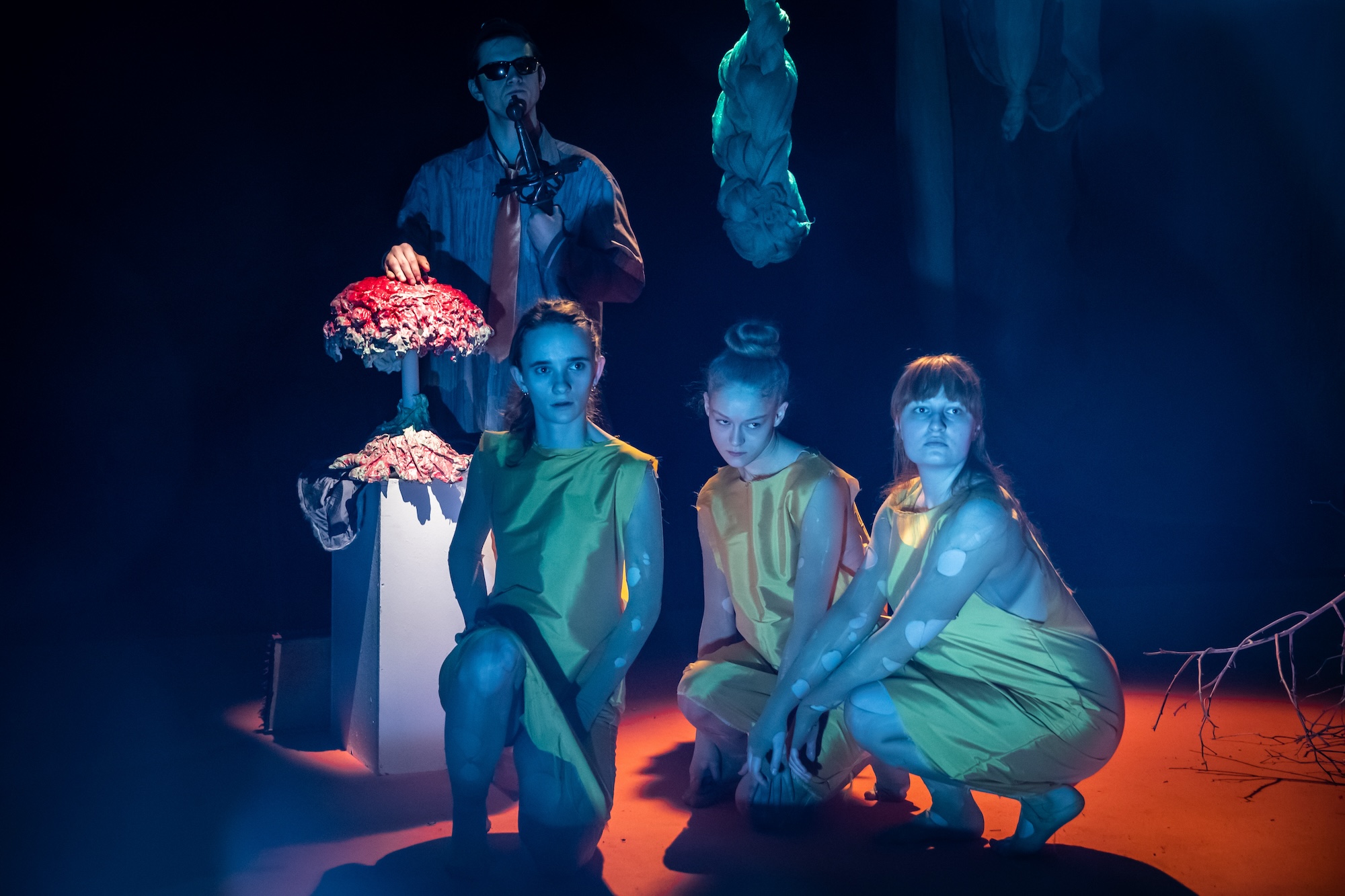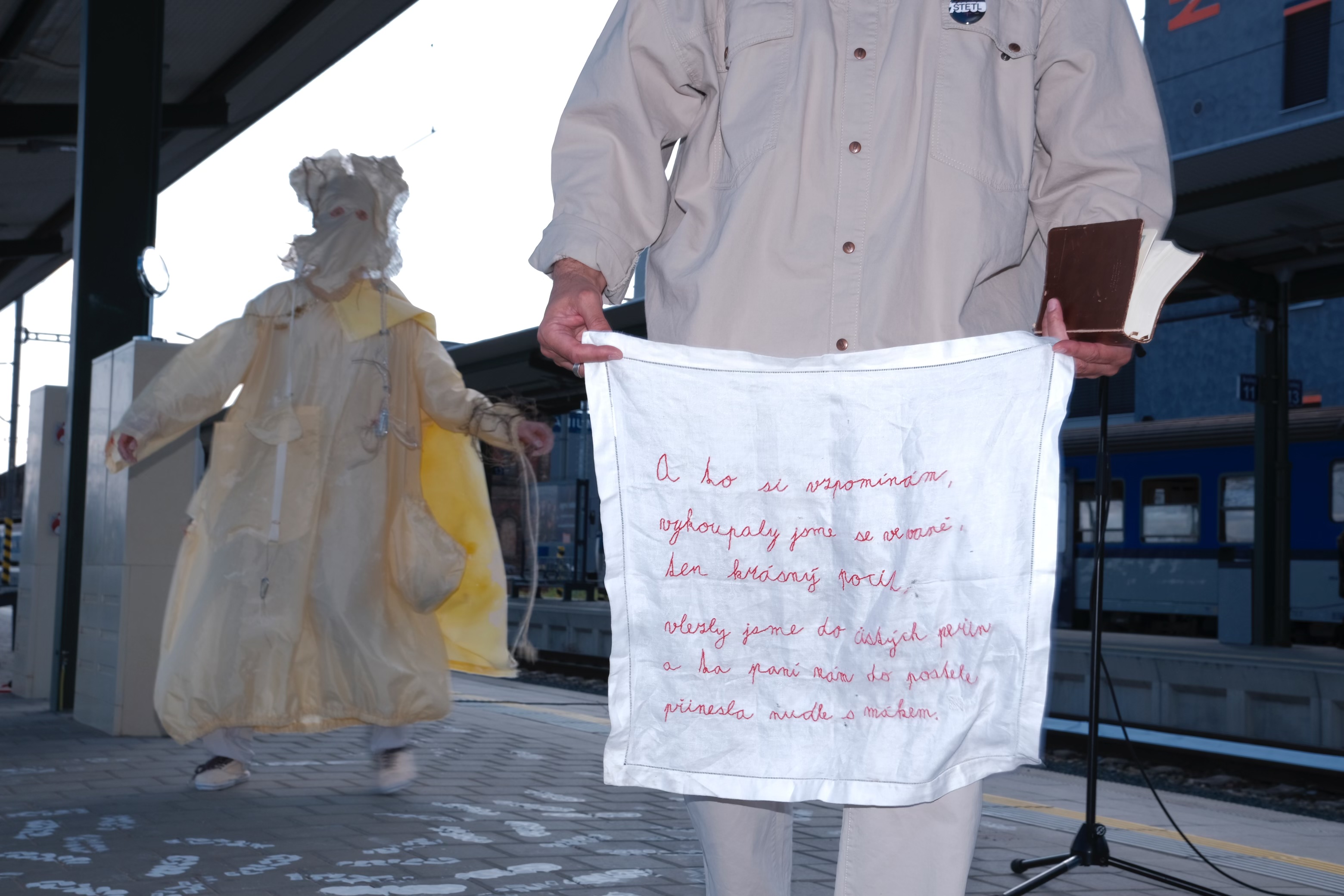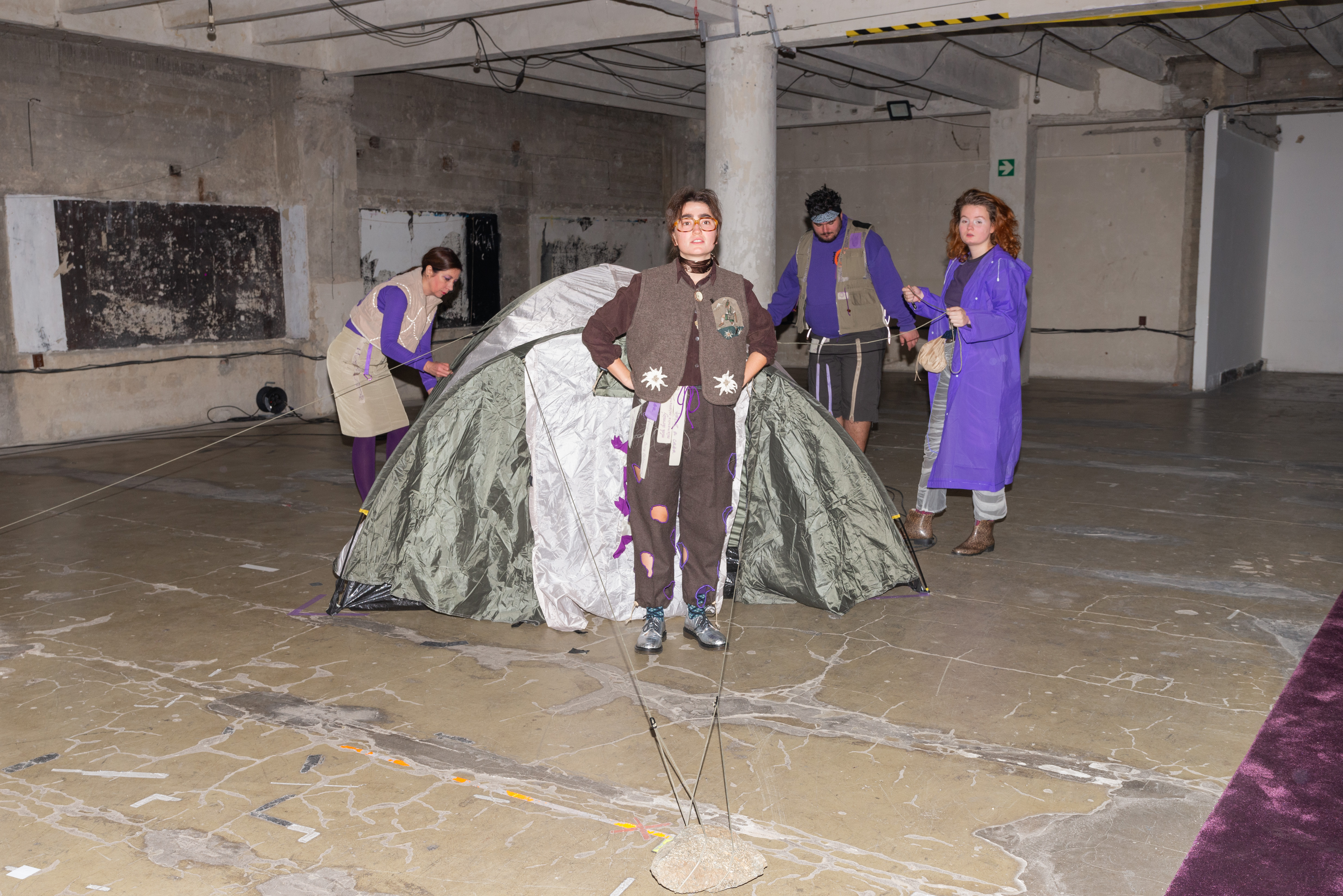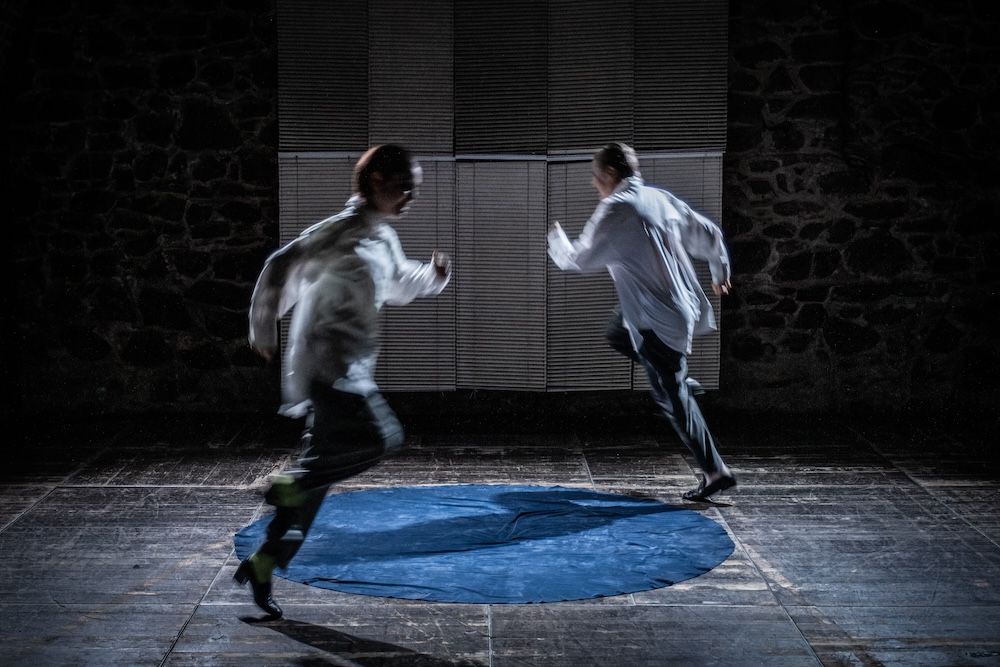
Collective of HaDivadlo in dialogue with the dramaturg of Husa na provázku Theatre
Members of the future HaDivadlo artistic direction team, Jan Doležel, Jana Vaverková and Justina Grecová, answer questions about their collaborative work, boundaries and theatrical visions in an interview with the dramaturg of the Husa na provázku Theatre, Veronika Onheiserová.
Veronika Onheiserová: Honza, Jana, Justina, where did you first meet? What was your first collaboration?
Justina Grecová: We met in the same directing and dramaturgy department at JAMU. From the beginning we felt a common direction, a similar perception of theatre and thinking about it. That's why in the third year we decided to combine our bachelor graduate production called Mé jméno budiž Gantenbein into one project and work on it as a collective. During our first collaboration we explored how our communication can work together, what its starting points are, what roles we can play within it. We were, simply put, looking at various boundaries of our collectivity and exploring the extent to which it is possible to function non-hierarchically.
What does collective work offer you? In what ways do you inspire each other? What unites you and what makes you different?
Jan Doležel: Collective thinking and creation enable an intensive and practically permanent revision of one's own views and approaches. It is a very sensitive field that requires honesty, consideration and, above all, the ability not only to promote one's own positions, but to give space to each other. It requires a great deal of effort and that is what unites us. At the same time, it should be mentioned that each one of us expresses our own efforts in a different way. Which brings diverse impulses into our creative dialogue.
Jana Vaverková: I think we inspire each other in our differences, in our opinions and in matters of taste. These differences bring new impulses to my vision of the world. Personally, I am inspired by Honza and Justina, especially as people who have the same drive to create and to find new approaches to creation. What pleases me the most is that within the collective we are able to take risks and step into the unknown. When you find a team like this, it's a bit of a miracle. You are not alone in your enthusiasm. Plus it's kind of a sampling of approaches, languages, aesthetics.
Justina: The identity of our productions and work is best defined by the collectivity itself. And by that I mean especially the overlap that our work has because we are together. Each of the three of us has a quite different approach to the work, although we agree on the very basics. The collectivity is imprinted in our work by the fact that the productions we create have different styles, different overlaps, and are often fragmented. What unites us is the ability to sense and agree together on a basic foundation and then to be willing to develop that foundation in different directions, to listen to each other and maybe even to accept that my opinion may not always be the best one or the one that comes to fruition.
How do you set professional boundaries in such a close, friendly relationship?
Jan: In the theatre, as the three of us perceive it, everything comes from an encounter, but it is not only a professional contact, but the personal life of each of us enters into it very strongly. We vouch by ourselves, creative work for me is not separable from the private area, the boundaries between them are fluid. Practically, this means that of course we have a defined time together for work obligations and a time when we meet without dealing with work, but there is almost always an intersection. Our work meetings usually start with an introductory block where we tell each other how each of us is feeling. This conscious structuring of our productive time also takes into account our current state and makes our relationships healthier. It's everyone's responsibility to be able to evaluate the degree of sharing and intersection of the personal with the professional. Boundaries are important, but I see them as an ongoing work in progress.

Mé jméno budiž Gantenbein (2023), Theatre faculty JAMU
Photo: Hana Ptáčková
You have already collaborated collectively on school projects (Mé jméno budiž Gantenbein, 2023), or as part of the ŠTETL festival (happening 1,000 Footsteps of the Disappeared, 2023; Noir Haas, 2024), and now you are about to premiere at Divadlo X10 Člověk se objevuje v holocénu. Do you find any connections between your various projects?
Jan: I would say that the mentioned projects are characterised by the desire to be personal. Whether we work with another author's text, theme or phenomenon, we never want to be a slave to it. It's a launching pad for us. And because there are at least three of us, such a reflection generates a variety of material. All of our previous works are linked by mosaicism, montage, but perhaps also by the carpet that covers part of the surface on which the actors and actresses move.
In your artistic concept, you mention your interest in locality and diversity of themes, you talk about the dramaturgy of experience. Are there any themes that you consider crucial but have not yet found a place on the Czech stages?
Jana: There are probably more topics that have no representation on the domestic scene. Or they are being covered, but maybe a bit poster-like, because they're currently topical. I don't think there is a right or wrong way to choose and cover topics, but the audience can sense when the topic really touches the creators and the intensity on stage is then priceless. Even if it may not be formally or aesthetically fulfilled according to their subjective ideas. I would like to see more works that are personally fulfilled. We are all trying to responsibly seek out themes to contribute to our collective " national" consciousness, but what's the point if they don't affect the creators personally? Such considerations lead to the core of collective inquiry and dialogue, of being true to oneself and knowing how to communicate that further.
Which artists or creative collectives inspire you with their work? Do you have any “dream” collaborators?
Jana: I have a lot of dream collaborators, often from a music or artistic background. And then there are the students! The productions that I've really enjoyed lately have mostly been student or graduate productions.
Justina: I am currently, for example, very inspired by the previous management of the Schauspielhaus Zürich co-intendants Nicolas Stemann and Benjamin von Blomberg. If I could work with anyone from their team, it would be quite a dream job for me at the moment.
Jan: I've gone through an evolution and I feel a lot of layers in me. As Max Frisch says, "We are swimming in a kind of cocktail that contains just about everything." Part of me is the initiation experiences from the Reduta Theatre, when it was artistically directed by Petr Štědroň and Dora Viceníková, and at the same time the era of Vladimír Morávek at Provázek. My starting point was these two Brno venues, which I began to discover very intensively at the turn of 2011/2012 and I still draw from them today. A few years later, I took a deep dive into the waters of German-language theatre and sobered up, but the attitude and productions of the Münchner Kammerspiele under the direction of dramaturg Matthias Lilienthal still resonate with me. If I were to jump to the present, I'm currently spending a lot of time with film director Sofia Coppola in my thoughts, so I have no doubt it's seeping into my work. In terms of dreams, I would love to work with J.A. Pitínský and Leonie Böhm.

1,000 Footsteps of the Disappeared (2023), ŠTETL Fest
Photo: Alžběta Drcmánková
How do you view the "era" of Ivan Buraj? What did it mean to you personally? And what does HaDivadlo itself mean to you?
Jana: Ivan's era appealed to me during my studies at JAMU mainly because of its peculiarity of attitude and a kind of stubbornness, which is personally close to me and provokes me at the same time. Through his productions, an era of my life called "I hate drama" came to an end for me. Combining the traditional with the new, thus creating an intergenerational dialogue and dealing with contemporary issues in a comprehensible way, I think, was really successful during Ivan's era. At the same time, what I appreciated most were the guest artists who gave the theatre a punk flavour, such as Kačena or Bambušek. As students we found a refuge and a place for spirited discussion in the theatre, the dramaturg Matěj Nytra always asked us what we thought of the show, well just a nice community environment. And what the HaDivadlo really means to us will be discovered in the years to come - at the moment, it is above all an opportunity and a refuge for creation.
HaDivadlo is part of the Centre for Experimental Theatre (CED) – how do you perceive it, what do you think its function should be?
Justina: Already when we were thinking about the artistic concept with which we applied for the tender, we perceived the topic of cooperation with CED as a very important point. Personally, I think that CED is unique (not only) in the Czech context. It is a huge advantage for us to be part of the trio of Brno theatres that have this unified coverage. I think the function of CED should be to take care of all three theatres (HaDivadlo, Husa na Provázku Theatre and Terén), to present them outwards, but also inwards within CED itself, to (self-)educate, but also to enable joint networking over projects and dramaturgical challenges and reflections. An integral part of the CED profiled in this direction is the CEDIT magazine, which explores crucial topics at the highest level and thus enables a cultivated social debate.
The Husa na provázku Theatre and Terén are also part of CED. Is there anything that connects them with HaDivadlo? What makes them different?
Jan: The CED is a consistent organization that has three distinct art institutions - all three share a commitment to live and explore our lived experience. I really appreciate the opportunity to confront three diversified voices that encourage dialogue. I enjoy Terén's programming, which takes me out of the sometimes somewhat closed theatrical environment and, most importantly, systematically reaches beyond our state's borders – names like Gob Squad and Wojtek Ziemlinski. After five years of this platform’s existance, it's becoming clear what an extraordinary project it is. I consider Husa na provázku Theatre to be one of the few theatres that carry a vibrant essence across time that transcends the individual eras associated with specific personalities. That's what has always fascinated me about Provázek, the strong confrontation with tradition. I can't imagine this fascinating struggle ceasing or not being able to follow it.

Člověk se objevuje v Holocénu (2025), X10 Theatre
Photo: Alžběta Drcmánková
What do you see as the key challenges of the contemporary Czech theatre environment? And if you could change one thing immediately, what would it be?
Jana: I think the biggest challenge is that theatre as such should not die, because it was and is one step behind other artistic disciplines. A lot of people find it embarrassing and too conservative, especially young people, unless they are theatre nerds – in a good way – like us and probably you who are reading this interview. I would really like theatre to come back from the dead on a regular basis and surprise, to be bold and to use its greatest potential, that we can meet and experience something intense together. I can't imagine a positive global change, the theatre's soil is organic and changes naturally on its own because people change, because society changes and theatre responds to those changes. Sometimes I'd just like to see that reaction faster and sharper, so maybe the answer is to change the pace and not just stay in the certainties proven by the past.
Your winning artistic concept is already available online, but can you summarise the key points you are coming up with as the new artistic directors? What will the Collective in Dialogue bring?
Justina: Collective in Dialogue is based, like our collaboration, on a focus on constant communication and listening, hence the name. We are interested in diversity, difference, identity, corporeality, relationship and dialogue with local issues and environments, female and collective heroes (and heroines). But we want to explore all of these phenomena through a personal identity perspective, from the inside, not the outside. Related to this is the decision to present thematic theatre seasons. In terms of specific titles, we combine original productions with interpretive ones. Some suggestions for titles therefore include, for example, an authorial production on Functionalism and Brutalism, an adaptation of Marek Torčík's contemporary novel Memory Burn, but also an authorial interpretation of classic dramatic text Gazdina Roba. As for the direction inside the theatre, it is mainly about our big goal and wish to create a strong and friendly collective with the whole ensemble.
What should HaDivadlo be like in 2028?
Jana: Wild.
Justina: A theatre with so many spectators that they won't even fit inside and will queue for the box office like in Dejvice (although...)
Jan: Unyielding and allowing people to be themselves.
One of your intended theatre seasons is called Talisman - do you each have your own? What kind of item is it and what does it bring you?
Jana: My talismans change a lot, but they are always gifts from someone I care about or connected to a major life event. Right now it's a rock.
Justina: I don't think I have a specific talisman. I'm a maximalist and I'm surrounded by a really large number of objects that I have a pretty strong relationship with. Anyway, probably the biggest personal talisman for me is my clothes. I have such a strong relationship and experience with some pieces of clothing that I can get overly emotional about it.
Jan: I don't have any talisman in the form of a specific object and I probably never had one. I think that the magical function, which is superior to the practical one that talismans usually fulfil, is in my case replaced by the unchanging constellations of certain everyday objects. This systematic, perhaps overly rational order can have a magical overlay for me.

Noir Haas (2024), ŠTETL Fest
Photo: David Konečný
What are you reading right now?
Justina: I'm currently reading the novel Memory Burn by Marek Torčík, which is also part of our artistic concept.
Jana: I went back to the book American Lectures by Italo Calvino.
Jan: Charlie Porter's book Bring No Clothes, about the Bloomsbury group's philosophy of clothing.
Your graduation production at Studio Marta is coming up – what do you plan to finish your studies at JAMU with?
Jana: First time using the proscenium. It's going to be a production of O?lando, a mash-up of two books: the novel Orlando by Virginia Woolf and the short story book Short Conversations with Hideous Men by David Foster Wallace. Hopefully it will be beautiful and disgusting in one.
The collective of Jan Doležel, Jana Vaverková and Justina Grecová will be based in HaDivadlo from the beginning of the 2025/2026 season, replacing after 10 years Ivan Buraj as artistic director.








